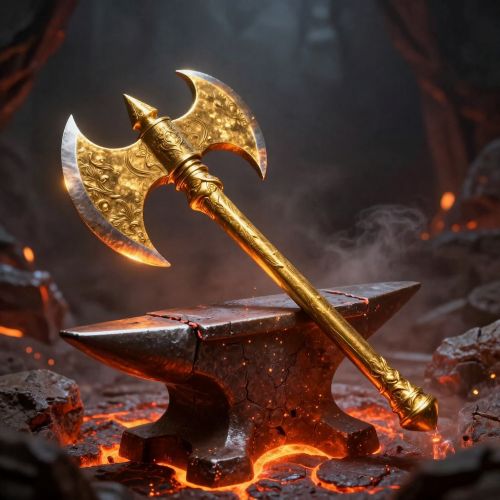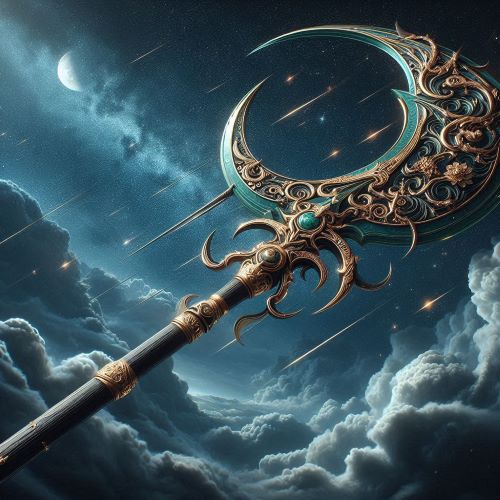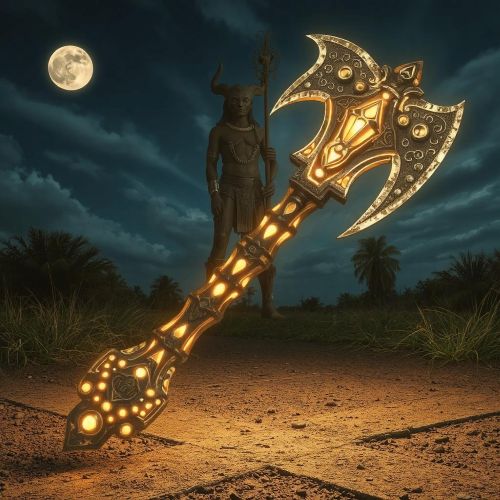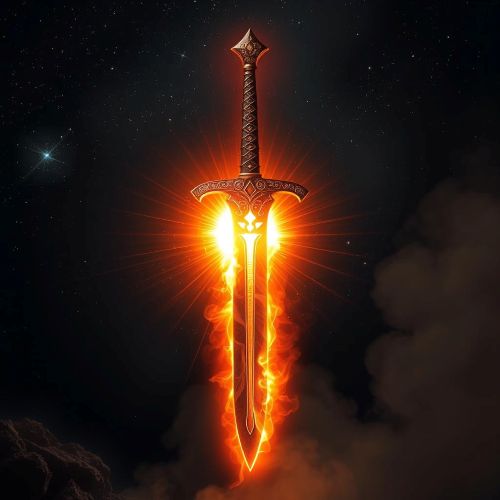Perun’s Axe : The Thunderous Blade
Perun’s Axe
Introduction
Perun’s Axe is one of the most iconic weapons in Slavic mythology, representing the supreme god Perun’s mastery over thunder, storms, and divine justice. Perun, often compared to Thor in Norse tradition or Zeus in Greek mythology, ruled as the sky-father and protector of order among the Slavs. His axe symbolized authority and balance, capable of both destruction and protection. Unlike a mere battlefield weapon, Perun’s Axe embodied cosmic law and the eternal struggle between chaos and harmony, securing its place as one of the most enduring symbols of pre-Christian Slavic faith.
Origins
The roots of Perun’s Axe can be traced to early Slavic belief systems, where lightning was seen as a visible sign of divine intervention. Linguistically, Perun’s name stems from the Proto-Indo-European root perkwu, meaning “to strike,” linking him with other thunder gods such as Baltic Perkūnas and Norse Thor. Archaeological discoveries of axe-shaped pendants, often called “hatchet amulets,” confirm the weapon’s importance as both a religious symbol and protective charm.
These miniature axes, most often crafted in bronze, were unearthed across regions like Russia, Ukraine, Poland, Lithuania, and the Balkans. Dating largely to the 11th and 12th centuries, the amulets exhibit two common designs. One resembled a bearded axe with circular motifs thought to represent the sun or celestial power. The other had a broader, symmetrical blade with horn-like projections, decorated with zigzag patterns symbolizing lightning. Their widespread use suggests a shared cultural reverence for Perun’s Axe, not just as a divine emblem but as a tangible connection to the god’s strength.
In shrines dedicated to Perun, often set beneath sacred oak trees, images of the god were accompanied by representations of his axe or hammer. These sanctuaries served as gathering points where tribes swore oaths, made sacrifices, and invoked Perun’s protection during times of war and uncertainty.
Think you know your myths and legends? Dive into the world of ancient stories and test your knowledge with our engaging quizzes on Mythlok!
Powers
Perun’s Axe was far more than a weapon of war. It channeled the god’s control over thunder and lightning, with each strike believed to unleash storms across the sky. When hurled at enemies, the axe returned unfailingly to Perun’s hand, much like Thor’s Mjolnir. This magical return underscored its role as a divine tool rather than a human creation.
Its powers extended beyond destruction. The axe was a force of justice, punishing liars, oath-breakers, and those who disrupted social and cosmic balance. Among ordinary people, amulets shaped like the axe were worn as protective charms against disease, misfortune, and malevolent spirits. Farmers prayed for Perun’s lightning to fall upon their fields in a controlled manner, blessing the land with rain rather than devastation.
Slavic folklore also introduced complementary weapons tied to Perun’s arsenal. Golden apples, described in songs and legends, carried immense destructive potential, symbolizing absolute divine wrath. In some traditions, thunderstones or prehistoric stone tools uncovered in the earth were believed to be fragments of Perun’s weapons, used by villagers as healing talismans or household protection against lightning strikes.
Owners/Users
In mythology, the Axe of Perun could only be wielded by the thunder god himself. As his principal weapon, it was inseparable from his identity as the celestial warrior and lawgiver. Yet, mortals engaged with its symbolic power through ritual and personal devotion.
Pre-Christian Slavs wore axe pendants around their necks to invoke Perun’s strength, courage, and protection. Warriors believed that carrying Perun’s Axe into battle gave them divine support, while hunters sought safety in the wilderness through its blessing. Religious leaders and tribal chiefs invoked Perun’s authority by swearing oaths upon the axe, using it as a sacred witness to truth and loyalty.
Historical chronicles, such as the Primary Chronicle of Kievan Rus’, record that treaties with the Byzantine Empire were sealed by oaths sworn in Perun’s name. In these ceremonies, his axe served as the divine guarantor of honesty and justice. Even after the Christianization of the Slavic lands, echoes of Perun’s worship persisted, with axe-shaped charms continuing to appear in burial sites and personal adornments.
Instances used
Perun’s Axe features prominently in mythological narratives that emphasize the conflict between order and chaos. The most enduring myth tells of Perun’s struggle against Veles, the serpent-like god of the underworld. Veles would steal cattle or treasures from the heavens and retreat to the watery depths. Perun pursued him relentlessly, hurling his axe across the skies. The resulting thunder and lightning symbolized the god’s strikes, while the storms represented his cosmic pursuit. This myth also explained natural cycles, where Perun’s victory restored balance and fertility to the land.
In folklore, the axe was not only a divine weapon but also a force for communal protection. Legends describe Perun striking down demons, giants, or malevolent spirits that threatened villages. In some accounts, his axe cleaved open the heavens to release life-giving rain, while in others, it scorched the earth to cleanse it of evil.
Archaeological evidence supports these beliefs through the discovery of dozens of axe amulets in sites across Eastern Europe. Locations such as Drustar, Preslav, and Păcuiul lui Soare yielded artifacts linked to military campaigns and trade routes, showing how the symbol of Perun’s Axe spread across cultures. The presence of these amulets in graves suggests that individuals carried their faith in Perun’s protection into the afterlife.
In modern times, Perun’s Axe has transcended mythology. It appears in popular culture, literature, and digital media as a mystical weapon associated with storms and divine justice. Video games and fantasy novels often reimagine the axe as an enchanted object with lightning powers, continuing its legacy as a symbol of strength and cosmic authority. For Slavic neopagan groups today, the axe remains a sacred emblem worn in rituals, connecting contemporary practitioners with their ancestral traditions.
Frequently Asked Questions
Lorem ipsum dolor sit amet, consectetur adipiscing?
Lorem ipsum dolor sit amet, consectetur adipiscing elit. Praesent convallis vestibulum justo, ac tincidunt nunc vehicula quis. Nullam id dolor quis orci malesuada feugiat. Curabitur aliquet libero at urna ullamcorper, ac ultricies nulla dapibus.
Lorem ipsum dolor sit amet, consectetur adipiscing?
Lorem ipsum dolor sit amet, consectetur adipiscing elit. Praesent convallis vestibulum justo, ac tincidunt nunc vehicula quis. Nullam id dolor quis orci malesuada feugiat. Curabitur aliquet libero at urna ullamcorper, ac ultricies nulla dapibus.
Lorem ipsum dolor sit amet, consectetur adipiscing?
Lorem ipsum dolor sit amet, consectetur adipiscing elit. Praesent convallis vestibulum justo, ac tincidunt nunc vehicula quis. Nullam id dolor quis orci malesuada feugiat. Curabitur aliquet libero at urna ullamcorper, ac ultricies nulla dapibus.
Lorem ipsum dolor sit amet, consectetur adipiscing?
Lorem ipsum dolor sit amet, consectetur adipiscing elit. Praesent convallis vestibulum justo, ac tincidunt nunc vehicula quis. Nullam id dolor quis orci malesuada feugiat. Curabitur aliquet libero at urna ullamcorper, ac ultricies nulla dapibus.
Lorem ipsum dolor sit amet, consectetur adipiscing?
Lorem ipsum dolor sit amet, consectetur adipiscing elit. Praesent convallis vestibulum justo, ac tincidunt nunc vehicula quis. Nullam id dolor quis orci malesuada feugiat. Curabitur aliquet libero at urna ullamcorper, ac ultricies nulla dapibus.
Watch
Source
ErnaWrites. (2019, July 1). Perun, Slavic God of Thunder – Myths & Stories. Retrieved from https://ernawrites.com/2019/07/02/perun-the-thunderer/
Paganheim. (2025, February 1). Thunder and Power: The Legacy of Perun in Slavic Mythology. Retrieved from https://paganheim.com/blogs/mythology/perun-supreme-deity-of-slavic-mythology
Mythlok. (2024, November 11). Perun: The Mighty Thunder God of Slavic Mythology. Retrieved from https://mythlok.com/perun/
TheCollector. (2024, October 5). 5 Facts About Perun, the Slavic God of Thunder. Retrieved from https://www.thecollector.com/perun-thunder-slavic-god-facts/
Wikipedia. (2003, March 24). Perun. Retrieved from https://en.wikipedia.org/wiki/Perun
Wikipedia. (2009, March 3). Axe of Perun. Retrieved from https://en.wikipedia.org/wiki/Axe_of_Perun
EBSCO. (2018, November 8). Perun | Research Starters. Retrieved from https://www.ebsco.com/research-starters/religion-and-philosophy/perun
Reddit. (2025, February 4). “Axes of Perun” amulets …were they really a thing? Retrieved from https://www.reddit.com/r/slavic_mythology/comments/1iapvaq/axes_of_perun_amulets_were_they_really_a_thing/








